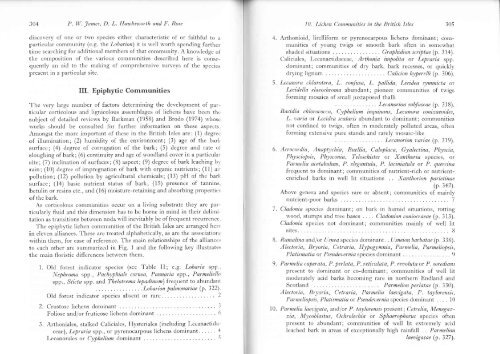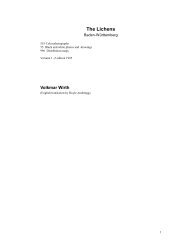Lichen communities in the British Isles: A preliminary conspectus
Lichen communities in the British Isles: A preliminary conspectus
Lichen communities in the British Isles: A preliminary conspectus
You also want an ePaper? Increase the reach of your titles
YUMPU automatically turns print PDFs into web optimized ePapers that Google loves.
30+ P. W. ./ames, l). L. Hawksworth and tr'. Rose<br />
discovcry of one or t\\'o spccies ei<strong>the</strong>r characteristic of or faithful to a<br />
particular community (e.g. <strong>the</strong> Lobarion) it is u'ell worth spend<strong>in</strong>g fur<strong>the</strong>r<br />
time search<strong>in</strong>g for additional members of that community. A knorvledge ol,<br />
<strong>the</strong> composition of <strong>the</strong> various <strong>communities</strong> described here is consequently<br />
an aid to <strong>the</strong> mak<strong>in</strong>g of comprehensive surveys of <strong>the</strong> specics<br />
present <strong>in</strong> a particular site.<br />
III. Epiphytic Cornrnunities<br />
The very large number of factors determ<strong>in</strong><strong>in</strong>g <strong>the</strong> development of particular<br />
corticolous and lignicolous assemblages of lichens have been tht'<br />
subject of detailed reviews by Barkman (1958) and Brodo (1974) whost<br />
works should be consulted for fur<strong>the</strong>r <strong>in</strong>formation on <strong>the</strong>se aspects<br />
Amongst <strong>the</strong> more important of thcse <strong>in</strong> <strong>the</strong> <strong>British</strong> <strong>Isles</strong> are: (1) degrct<br />
of illum<strong>in</strong>ation; (2) humidity of <strong>the</strong> environment; (3) age of <strong>the</strong> barli<br />
surfacc; (4) degree of corrugation of <strong>the</strong> bark; (5) degree and rate o1<br />
slough<strong>in</strong>g of bark; (6) cont<strong>in</strong>uity and age of woodland cover <strong>in</strong> a particular<br />
site; (7) <strong>in</strong>cl<strong>in</strong>ation of surfaces; (B) aspect; (9) degree of bark leach<strong>in</strong>g br<br />
ra<strong>in</strong>; (10) degree of impregnation of bark with organic nutrients; (11) air<br />
pollution; (12) pollution by agricultural chemicals; (13) pH of <strong>the</strong> barl<br />
surface; (14) basic nutrient status of bark; (15) presence of tann<strong>in</strong>s<br />
betul<strong>in</strong> or res<strong>in</strong>s etc., and (16) moisture-reta<strong>in</strong><strong>in</strong>g and absorb<strong>in</strong>g propertic,<br />
of <strong>the</strong> bark.<br />
As corticolous comrnunities occur on a liv<strong>in</strong>g substrate <strong>the</strong>y are par.<br />
ticularly fluid and this dimension has to be borne <strong>in</strong> m<strong>in</strong>d <strong>in</strong> <strong>the</strong>ir delimitation<br />
as transitions between noda will <strong>in</strong>evitably be of frequent recurrencc<br />
'Jihe epiphytic lichen <strong>communities</strong> of <strong>the</strong> <strong>British</strong> <strong>Isles</strong> are arranged herc<br />
<strong>in</strong> cleven alliances. These are treated alphabetically, as are <strong>the</strong> associations<br />
with<strong>in</strong> thcm, for ease of reference. The ma<strong>in</strong> relationships of <strong>the</strong> alliances<br />
to each o<strong>the</strong>r are summarized <strong>in</strong> Fig. 1 and <strong>the</strong> follow<strong>in</strong>g key illustrates<br />
<strong>the</strong> ma<strong>in</strong> floristic differcnces between <strong>the</strong>m.<br />
1. Old forest <strong>in</strong>dicator species (see 'lable II; e.g. Lobaria spp '<br />
l{ephroma spp., Pachyphiale cornea, Pannaria spp., Parmelielltt<br />
spp., Slecla spp. and Thelotrema lepad<strong>in</strong>um) frequent to abunclant<br />
old forest <strong>in</strong>dicator ;p;i". ;;;"; ::':i': i:^'."':'::': t.'O,<br />
2. Crustosclichensdom<strong>in</strong>ant .........1<br />
Iioliose and/orfruticose lichens dom<strong>in</strong>ant . '. ' '... (<br />
3. Arthoniales, stalked Caliciales, Hysteriales (<strong>in</strong>clud<strong>in</strong>g Lecanacticiaceac),<br />
Lepra.ria spp., or pyrenocarpous lichens dom<strong>in</strong>ant...... 4<br />
I,ecanoralesorCltpheliumdom<strong>in</strong>ant ......5<br />
+.<br />
-5.<br />
6.<br />
7.<br />
8.<br />
9.<br />
10.<br />
10. <strong>Lichen</strong> Communities <strong>in</strong> <strong>the</strong> <strong>British</strong>. Isle.s<br />
Arthonioid, lirelliform or pyrenocarpous lichens dom<strong>in</strong>ant; cornmunities<br />
of young twigs or smooth bark often <strong>in</strong> somcwhat<br />
shaded situations . . . . Graphiclion sa,iptae (p. 31a).<br />
Caliciales, Lecanactidaceae, Arthonia impolita or Lepraria spp.<br />
dom<strong>in</strong>ant; <strong>communities</strong> of dry bark, bark recesses, or quickly<br />
dry<strong>in</strong>g lignum . . Calicion hyperelli (p. 306).<br />
Lecanora cltlat,otera, L. confusa, L. pallida, Lecidea symmi.cta or<br />
Lecidella ela.eochroma abundant; pioneer <strong>communities</strong> of tu'igs<br />
form<strong>in</strong>g mosaics of small juxtaposed thalli<br />
. . Lecanorion subfuscae (p. 318).<br />
Bacidia clt.lorococca, Cyphelium <strong>in</strong>qu<strong>in</strong>ans, Lecan.ora cottizaeoides,<br />
L. z;aria or Lecidea scalaris abundant to dom<strong>in</strong>ant; <strong>communities</strong><br />
not conf<strong>in</strong>ed to twigs, often <strong>in</strong> moderatcly polluted areas, often<br />
rorm<strong>in</strong>g extensive<br />
:::: ':Ti: .^".0 :*":!,il:;:o;-'ili,,,(p. 31e)<br />
Acrocordia, Anaptychia, Buellia, CaLoplaca, Gyalect<strong>in</strong>a, Physcia,<br />
Physciopsis, Physconia, Teloschtlstes or Xanthon.zz species, or<br />
Parmelia acetabulum, P. elegantula, P. lac<strong>in</strong>iatula or P. querc<strong>in</strong>a<br />
frequent to dom<strong>in</strong>ant; <strong>communities</strong> of nutrient-rich or nutrientenriched<br />
barks <strong>in</strong> well lit situations . . Xanthorion pariet<strong>in</strong>ae<br />
(P.3+2)-<br />
Above genera and specics rare or absent; <strong>communities</strong> of ma<strong>in</strong>ly<br />
nutrient-poor barks ... .. . 7<br />
Cladonia species dom<strong>in</strong>ant; on bark <strong>in</strong> humicl situations, rott<strong>in</strong>g<br />
wood, stumps ancl tree bases . ... Cladonion coniocraeae (p. 313).<br />
Cladonia species not dom<strong>in</strong>ant; <strong>communities</strong> ma<strong>in</strong>ly of well lit<br />
sites.. ......8<br />
Ramal<strong>in</strong>a an d/or (t snea species dom<strong>in</strong>ant . . LJ sneion ltat b atae (p. 3 3 8).<br />
Alectctria, Bryoria, Cetraria, Hypogymnia, Parmelia, Parmeliopsis,<br />
Platismatia or Pseudeteraia species dom<strong>in</strong>ant . . . . 9<br />
Parmelia caperata, P. perlata, P. reticulata, P. reaoluta or P. soredians<br />
present to dom<strong>in</strong>ant or co-dom<strong>in</strong>ant; <strong>communities</strong> of well lit<br />
moderately acid barks becom<strong>in</strong>g rare <strong>in</strong> nor<strong>the</strong>rn Endland and<br />
Scotland Pat melion perlatae (p. 33U).<br />
Alectoria, Bryoria, Cetraria, Paymelia laexigata, P" taylorensis,<br />
Parmeliopsis, Platismatia or Pseudexerzra species dom<strong>in</strong>ant . . . . 10<br />
Parmelia laez;igata, and/or P. taylorensis present; Cetreh)a, Menegazzia,<br />
Mycoblastus, Ochrolechia or Sphaerophorus species often<br />
present to abundant; <strong>communities</strong> of well lit extremely acid<br />
ieached bark <strong>in</strong> areas of exceptionally high ra<strong>in</strong>fall . . Parmel,ion<br />
laeaigatae (p. 327).<br />
305





